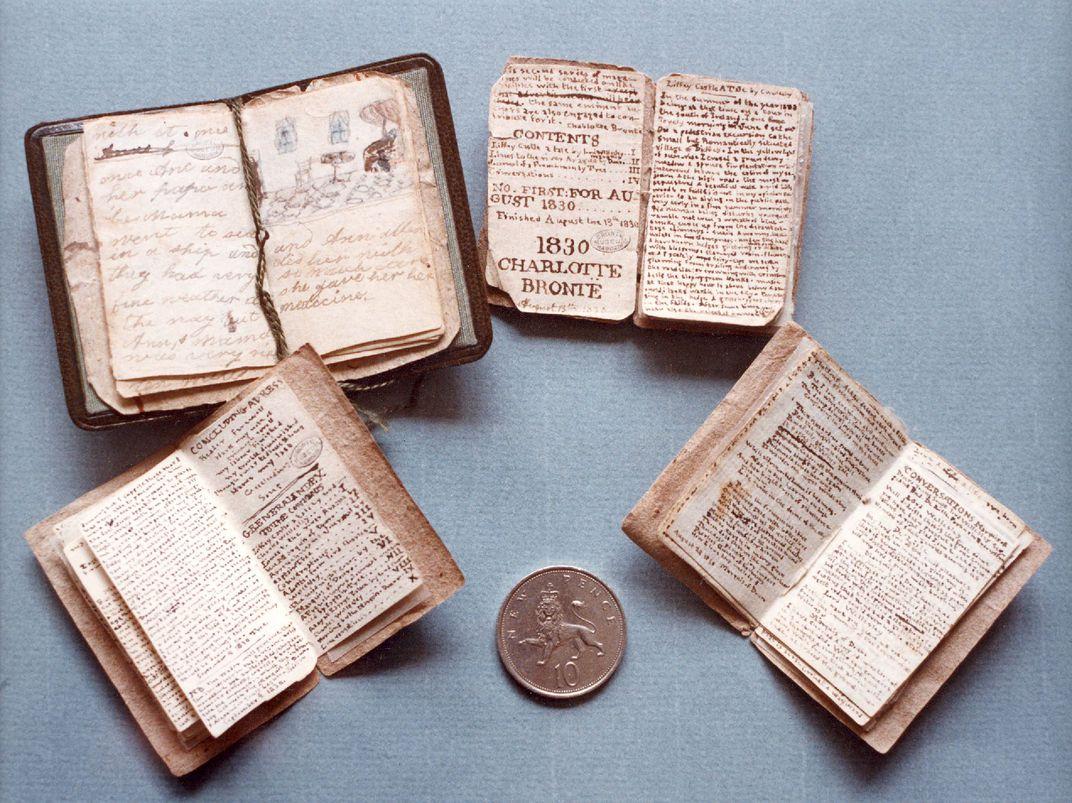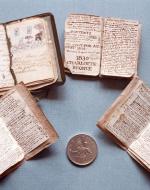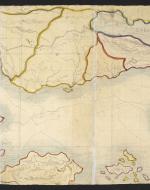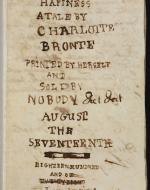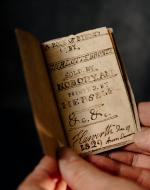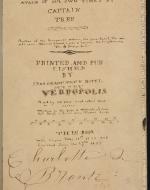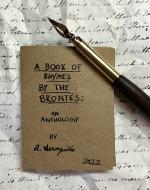Created by Allison Serapilio on Wed, 10/12/2022 - 19:19
Description:
In spite of numerous hardships faced at the beginning of their short lives including both parental and familial loss, all four of the Brontë siblings managed to create miniature inventive books of great humor, creativity, and literary promise. Charlotte, the eldest, followed by Branwell, Emily, and Anne, each created poems, short stories, magazines, and manuscripts in their youth. Despite their miniature size, the books created by these miniature authors exceed readers' material expectations through grandeur of wit, charm, and scale. While the vast majority of Brontë juvenilia has been lost and damaged over time, the mere few dozen that remain of the around 100 known miniature books that existed are products of the siblings' childhood endeavors and imaginations. Miniature books allow us a window into the early careers of these incredible writers, particularly Charlotte, whose works are now widely considered to be hallmarks of the English literary canon. These childhood creations were largely made from found materials and leftover parchment, carefully sewn together, and later written on with dip pens and ink to record finalized versions of previously written drafts. This process of drafting, revision, and further refinement shows an incredibly sophisticated understanding of writing processes for children of a mere 12 and 13 years of age, illustrating their natural aptitude for writing and publishing which clearly served the siblings well in their later years. Through studying the miniature books and juvenilia created by the Brontë siblings in their youth, we can trace the trajectory of their writing into their later novels and writings, allowing us a fully-formed view into the literary narrative of the Brontë family.
Various Miniature Books Created by the Brontë Siblings, circa 1826-30, Brontë Parsonage Museum. The books and stories the Brontës created are characterized by their petite size and scale. Most miniature books of the family were incredibly small, measuring 2 x 1.5 inches with text so small that it was illegible without a microscope. The inclusion of a ten-pence coin (similar in size to an American quarter) in this image effectively demonstrates their size. Due to the size and relative illegibility of their creations, the books the siblings made are uniquely their own. The perfect size for the small hands even of a child, these books gave the Brontë children a sense of agency of their own which is especially poignant due to the rigid expectations for children in Victorian society. The Brontë siblings' Their books held power to make the children feel like giants, straight out of the juvenilia, which often included giants or miniature people in their narratives.
These miniature books also teach us about the physical act of creating books as well as the physicality of the books themselves. The physical process of creating the books was something that specifically Charlotte loved and cherished, which is why I will be primarily focusing on Charlotte's miniature books in this case. Books were much more expensive and less commonplace than they are today, as bookmaking was a time-consuming and laborious process in the Victorian period. Due to the high cost of bookmaking materials, most notably paper, the siblings repurposed old package wrappings, sugar wrappers, book pages, and scraps of wallpaper to create their books. These books were kept safe and secure, not to be played with and manhandled as the characters of the Brontë sisters often do in their novels. The books the siblings made are ones that welcome touch, interaction, and play. Through their creation of these elaborate books designed on such a small scale, we glean the value that the siblings placed on the physical experience of reading and story creation.
Branwell Brontë, Map of the Glass Town Federation in The History Of The Young Men From Their First Settlement To The Present Time, 1830-31, British Library. As young children, all four Brontë siblings were remarkably collaborative and imaginative thinkers. The fictional land of the "Glass Town Federation" is a direct result of this creative spirit, a collaborative setting for the majority of the siblings' earliest manuscripts and poetry. Primarily created by the older Charlotte and Branwell with later additions from the younger Emily and Anne, the world was envisioned to be a setting of journey, war, and triumph for young Branwell's twelve toy soldiers gifted to him by his father, Reverend Patrick Brontë. Each Brontë sibling identified as a particular toy soldier, ruling over each of the four kingdoms present in this incredibly detailed fictional world. Wellington's Land, Parry's Land, Sneaky's Land, and Ross's Land were governed by Charlotte's, Emily's, Branwell's, and Anne's toy soldiers, respectively. As seen in this map of Glass Town, the siblings devised intricate details later included in their soldiers' adventures; each kingdom has numerous geographical details including mountainous areas, bodies of water, and even a central commercial center, Verdopolis. All four Brontë siblings created tales with Glass Town as a setting although Branwell's and Charlotte's are the ones that remain the most intact while the majority of Emily's and Anne's writings have been lost. This highly complex land acts as the genesis for the more well-known worlds of Gondal and Angria, more directly inspiring the later works of the Brontë siblings that are studied so widely today.
Charlotte Brontë, Untitled Miniature Book, 1826-28, Brontë Parsonage Museum. This book, also pictured in the top left-hand corner of the first image in this case, is believed to be the oldest miniature book created by Charlotte and subsequently Charlotte's oldest known work. Created between 1826 and 1828 for her youngest sister, Anne, Charlotte filled the pages of this book with stories based in Glass Town with a map of the lands included among the book's many tiny watercolor illustrations and references to Emily and Charlotte's respective toy soldiers, Wellington and Perry. This book in particular shows the juvenile nature of the Brontë siblings' miniature creations with much more professional-looking and legibly written miniature tales created a few years later in their lives. This is undeniably Charlotte's most charming miniature book with its multitude of beautiful illustrations flanked at both the beginning and the end by scraps of flower-patterned wallpaper, bound nicely with what seems to be a cloth or leather miniature cover.
Charlotte Brontë, The Search After Happiness, 1829, British Library. Charlotte's The Search After Happiness, written when she was thirteen, tells the tale of a discontented man called Henry O'Donell, who goes on a journey to find happiness and contentment in his life. Set in Glass Town, the narrative adds to the immersive, expansive world the children created. Despite being a full five chapters, the book is still incredibly tiny with a hand-sewed binding and handwritten text. Charlotte frequently used this specific handwriting when writing her smaller works to mimic the standardized typeface of traditionally published books. Charlotte spent hours upon hours handwriting all of her stories with dip pens, writing so small she could squeeze huge stories into their tiny bindings.
Charlotte Brontë, A Book of Rhymes, 1829, Brontë Parsonage Museum. Little Charlotte's A Book of Rhymes is one of the most recent discoveries made in the world of Brontë juvenilia. It was donated to the Brontë Parsonage after being sold at an auction for $1.25 million in April of 2022. This miniature book of poems measures a mere 3.8 x 2.5 inches, containing what is believed to be the last ten unpublished and unread Charlotte Brontë poems in existence. The book is bound together using stitches as many other Brontë miniature books are and created from scraps of paper found around the Brontë family parsonage. Containing a similar inscription on the title page as is included in The Search After Happiness, Charlotte declares that her tiny anthology is "Sold by Nobody and Printed by Herself," a statement quite poignant given her future as one of the most well-read, sold, and printed authors of all time. Despite being written in the same year as The Search After Happiness (1829), the craftsmanship in this work shows her maturation as a girl and a writer; the title page is noticeably neater with fewer spelling and writing mistakes than in her previous work. By tracking the creation of these miniature books, we can subsequently track Charlotte's gradual improvement as a writer.
Charlotte Brontë, The Foundling, 1833, British Library. Written at the age of 17, The Foundling is a manuscript from Charlotte's later years as a youth writer. While this is not necessarily a miniature book in terms of physicality, its mere 18-page length designates it to be a small short story and a precursor to the longer works she produced in her later years. Charlotte's manuscript is set in the city's central cosmopolitan area, Verdopolis following an orphan called Edward Sydney. Directionless, Edward finds friendship, refuge, conflict, and wealth after traveling to Verdopolis. Edward receives his inheritance at the end of the novelette after his marriage to the character Julia. Parental loss and Inheritance are both central topics in Victorian literature, even acting as a central plot points in Charlotte's most successful novel, Jane Eyre (1847). This manuscript shows a strong maturation in the scale, skill, and care present in the writing of Charlotte Brontë which follows her into her adult writing life. Similar to Charlotte's The Foundling, Branwell wrote his manuscript entitled The History Of The Young Men From Their First Settlement To The Present Time at the age of 13. The narrative follows Brontë's twelve toy soldiers through an expedition to the West of Africa in an effort to establish the Glass Town Federation colony. Upon arrival in Africa, the soldiers build a settlement and later battle the native peoples of the area, the "Ashantees" (believed to be inspired by Charlotte's nine-pins bowling set), effectively establishing the colony.
Allie Serapilio, A Book of Rhymes by the Brontës, 2022. I made this miniature book in an effort to understand the material process of childhood bookmaking for the Brontë siblings, using their methods of book creation to make my own. I used old scraps of journal pages and paper bags, emulating the sugar wrappers and wallpaper clippings the Brontë children used ro craft their works. As for the writing inside the book, I used a dip pen and ink as the siblings would have done, writing carefully with small penmanship as Charlotte did in her books. Inspired by the appearance and contents of Charlotte's A Book of Rhymes (1829), I created a Brontë verse-focused anthology with lines and excerpts from various published poems by Charlotte, Emily, and Anne. As we do not have access to miniature books by Emily and Anne, I wanted to include their experiences with childhood bookmaking in some form, and this book effectively ties in the significance of Emily and Anne's work with Charlotte's. Specifically including their adult published poetry in the form of a miniature book intertwines the Brontë family's past with its future, connecting their juvenilia to their enduring legacy as arguably the most widely read family in English literary history.

